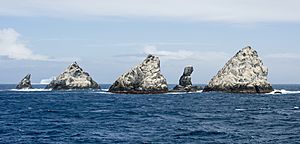Shag Rocks (South Georgia) facts for kids
 |
|
| Geography | |
|---|---|
| Coordinates | 53°32′51″S 42°01′12″W / 53.54750°S 42.02000°W |
| Archipelago | South Georgia |
| Area | 20 ha (49 acres) |
| Highest elevation | 75 m (246 ft) |
| Administration | |
| Demographics | |
| Population | 0 |
The Shag Rocks are a group of six small rocks in the South Atlantic Ocean. They are not big islands, but tiny land pieces called islets. These rocks are part of South Georgia, a British overseas territory. They are located far west of the main island of South Georgia. They are also quite a distance from the Falkland Islands. In Spanish, they are known as Islas Aurora.
Contents
About the Shag Rocks
The Shag Rocks cover a very small area, less than 20 hectares. This is about the size of 20 football fields. The highest point on these rocks is 75 meters (246 feet) above the sea. The water around them is quite deep, about 319 meters (1,047 feet).
Weather and Nature
The weather at Shag Rocks is usually cold. The average temperature is about -1.2°C (29.8°F). It rarely gets warmer than 15°C (59°F). There are no big plants growing on the rocks. However, the rocks are covered in guano. Guano is the droppings of seabirds.
Wildlife at Shag Rocks
The Shag Rocks are home to many seabirds. The main birds you can find there are the South Georgia shags. These birds are a type of cormorant. You can also see prions and large wandering albatrosses. These birds use the rocks as a place to rest and nest.
History of Discovery
The Shag Rocks have an interesting history of being found and named.
Early Sightings
The rocks were first seen by Jose de la Llana in 1762. He was on a Spanish ship called the Aurora. Because of his ship's name, he called them the Aurora Islands. Other Spanish ships visited the area later. The San Miguel visited in 1769. The Aurora came back in 1774. Then, the Princesa and the Dolores were there in 1779. In 1794, the Spanish ship Atrevida made maps of the Aurora Islands.
However, some people think these early sightings might have been a mistake. They believe the Aurora Islands were not exactly the same as the Shag Rocks we know today.
Later Discovery and Naming
The rocks were later found again by James P. Sheffield. He gave them their current name, Shag Rocks. This name probably came from the many shags and other seabirds that visit them. In 1927, people from the Discovery Investigations mapped the rocks using a ship called the William Scoresby.
First Landing
The first time anyone is known to have landed on the Shag Rocks was in 1956. An Argentine geologist named Mario Giovinetto was lowered onto the rocks from a helicopter. He collected rock samples to study them.
See also
 In Spanish: Islas Aurora para niños
In Spanish: Islas Aurora para niños

